remote start RENAULT KANGOO 2018 Owners Manual
[x] Cancel search | Manufacturer: RENAULT, Model Year: 2018, Model line: KANGOO, Model: RENAULT KANGOO 2018Pages: 264, PDF Size: 7.09 MB
Page 9 of 264

1.3
Radio frequency remote
control operating range
This varies according to the surround-
ings: take care not to lock or unlock the
doors by inadvertently pressing the but-
tons on the remote control.
Interference
Interference by factors in the immediate
vicinity (external installations or the use
of equipment operating on the same
frequency as the remote control) may
affect the operation of the remote con-
trol.
Note: if a door is not opened within
approximately 2 seconds of the door
being unlocked by remote control, the
doors will lock again automatically.
KEY, RADIO FREQUENCY REMOTE CONTROL: general information (2/2)
For replacement, or if you
require an additional remote
control.
You must only contact an approved
Dealer.
– To replace a remote control, the vehicle must be taken to an ap-
proved Dealer as both the vehi-
cle and the remote control are
needed to initialise the system.
– Depending on the vehicle, you have the option of using up to
four remote controls.
Remote control unit failure
Make sure that the correct battery
type is being used, and that the
battery is in good condition and in-
serted correctly. These batteries
have a service life of approximately
two years.
To learn how to change the battery,
please refer to the information on
the “Key, radio frequency remote
control: Batteries” in Section 5.
Driver’s responsibility
when parking or stopping
the vehicle
Never leave an animal,
child or adult who is not self-suffi-
cient alone in your vehicle, even for
a short time.
They may pose a risk to themselves
or to others by starting the engine,
activating equipment such as the
electric windows or locking the
doors, for example.
Also, in hot and/or sunny weather,
please remember that the tempera-
ture inside the passenger compart-
ment increases very quickly.
RISK OF DEATH OR SERIOUS
INJURY.
Page 11 of 264
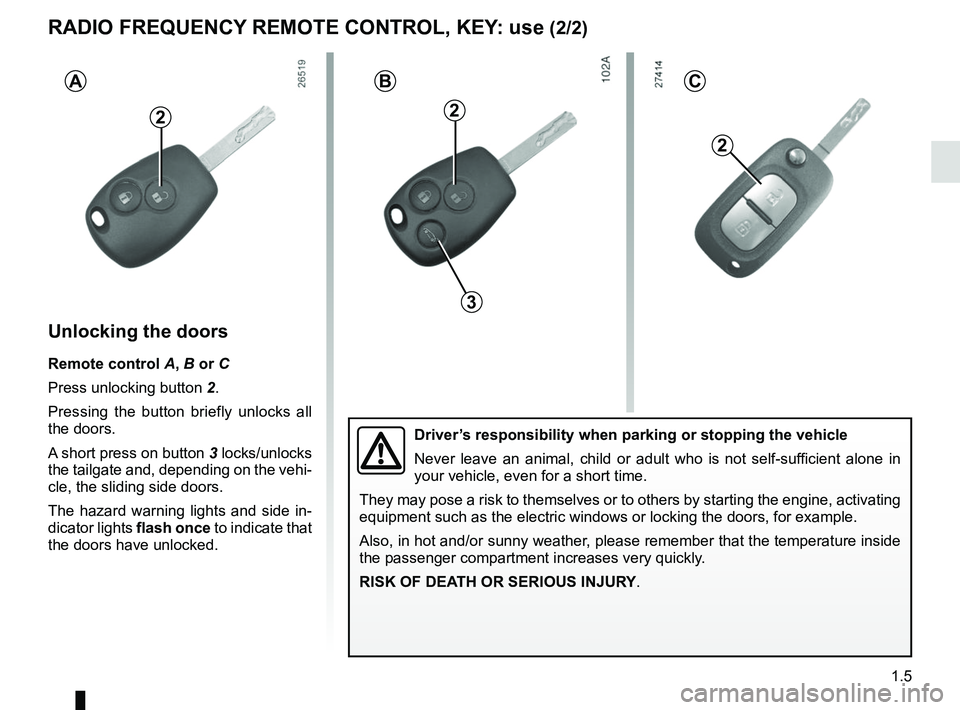
1.5
2
Unlocking the doors
Remote control A, B or C
Press unlocking button 2.
Pressing the button briefly unlocks all
the doors.
A short press on button 3 locks/unlocks
the tailgate and, depending on the vehi-
cle, the sliding side doors.
The hazard warning lights and side in-
dicator lights flash once to indicate that
the doors have unlocked.
AB
2
RADIO FREQUENCY REMOTE CONTROL, KEY: use (2/2)
2
3
Driver’s responsibility when parking or stopping the vehicle
Never leave an animal, child or adult who is not self-sufficient alone in
your vehicle, even for a short time.
They may pose a risk to themselves or to others by starting the engine, \
activating
equipment such as the electric windows or locking the doors, for example\
.
Also, in hot and/or sunny weather, please remember that the temperature inside
the passenger compartment increases very quickly.
RISK OF DEATH OR SERIOUS INJURY.
C
Page 17 of 264
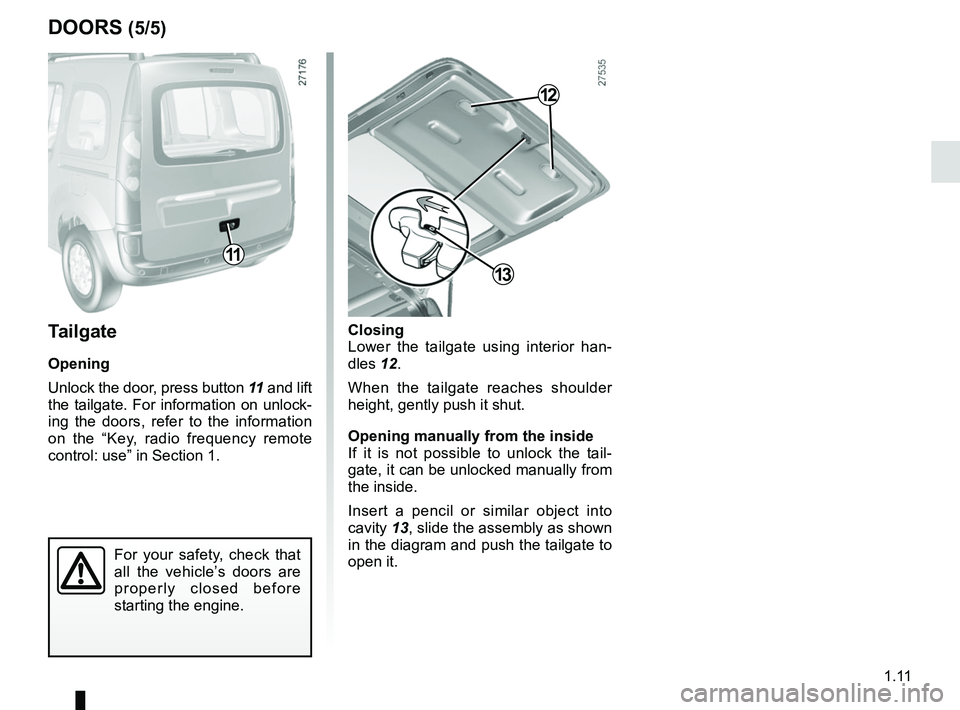
1.11
Closing
Lower the tailgate using interior han-
dles 12.
When the tailgate reaches shoulder
height, gently push it shut.
Opening manually from the inside
If it is not possible to unlock the tail-
gate, it can be unlocked manually from
the inside.
Insert a pencil or similar object into
cavity 13, slide the assembly as shown
in the diagram and push the tailgate to
open it.Tailgate
Opening
Unlock the door, press button 11 and lift
the tailgate. For information on unlock-
ing the doors, refer to the information
on the “Key, radio frequency remote
control: use” in Section 1.
For your safety, check that
all the vehicle’s doors are
properly closed before
starting the engine.
11
13
12
DOORS (5/5)
Page 36 of 264
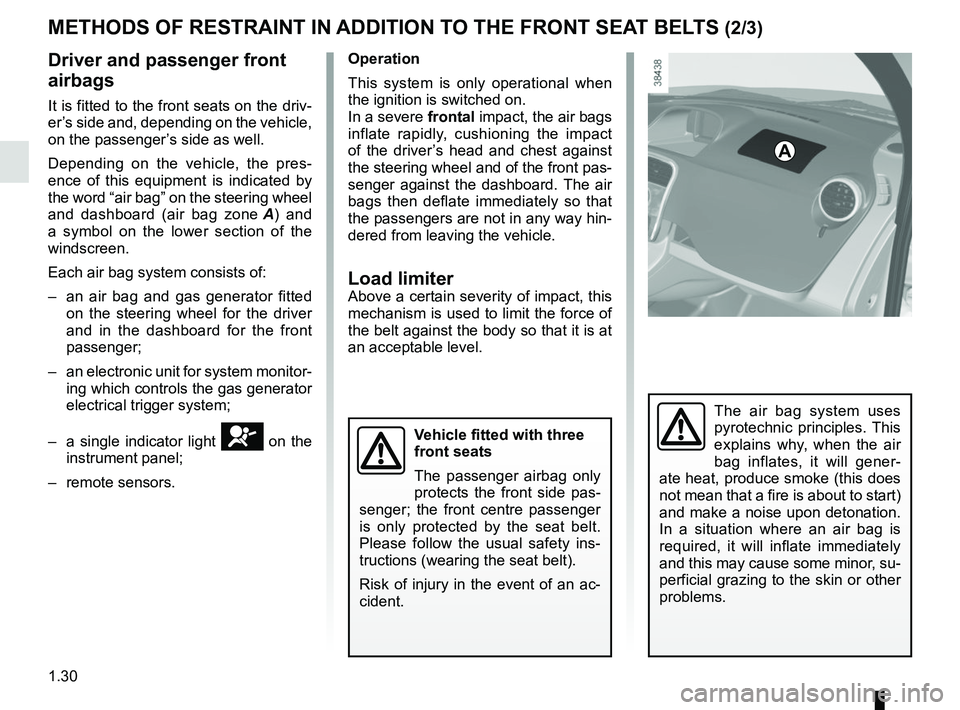
1.30
METHODS OF RESTRAINT IN ADDITION TO THE FRONT SEAT BELTS (2/3)
Driver and passenger front
airbags
It is fitted to the front seats on the driv-
er’s side and, depending on the vehicle,
on the passenger’s side as well.
Depending on the vehicle, the pres-
ence of this equipment is indicated by
the word “air bag” on the steering wheel
and dashboard (air bag zone A) and
a symbol on the lower section of the
windscreen.
Each air bag system consists of:
– an air bag and gas generator fitted on the steering wheel for the driver
and in the dashboard for the front
passenger;
– an electronic unit for system monitor- ing which controls the gas generator
electrical trigger system;
– a single indicator light
å on the
instrument panel;
– remote sensors.
A
Operation
This system is only operational when
the ignition is switched on.
In a severe frontal impact, the air bags inflate rapidly, cushioning the impact
of the driver’s head and chest against
the steering wheel and of the front pas-
senger against the dashboard. The air
bags then deflate immediately so that
the passengers are not in any way hin-
dered from leaving the vehicle.
Load limiterAbove a certain severity of impact, this
mechanism is used to limit the force of
the belt against the body so that it is at
an acceptable level.
The air bag system uses
pyrotechnic principles. This
explains why, when the air
bag inflates, it will gener-
ate heat, produce smoke (this does
not mean that a fire is about to start)
and make a noise upon detonation.
In a situation where an air bag is
required, it will inflate immediately
and this may cause some minor, su-
perficial grazing to the skin or other
problems.
Vehicle fitted with three
front seats
The passenger airbag only
protects the front side pas-
senger; the front centre passenger
is only protected by the seat belt.
Please follow the usual safety ins-
tructions (wearing the seat belt).
Risk of injury in the event of an ac-
cident.
Page 57 of 264
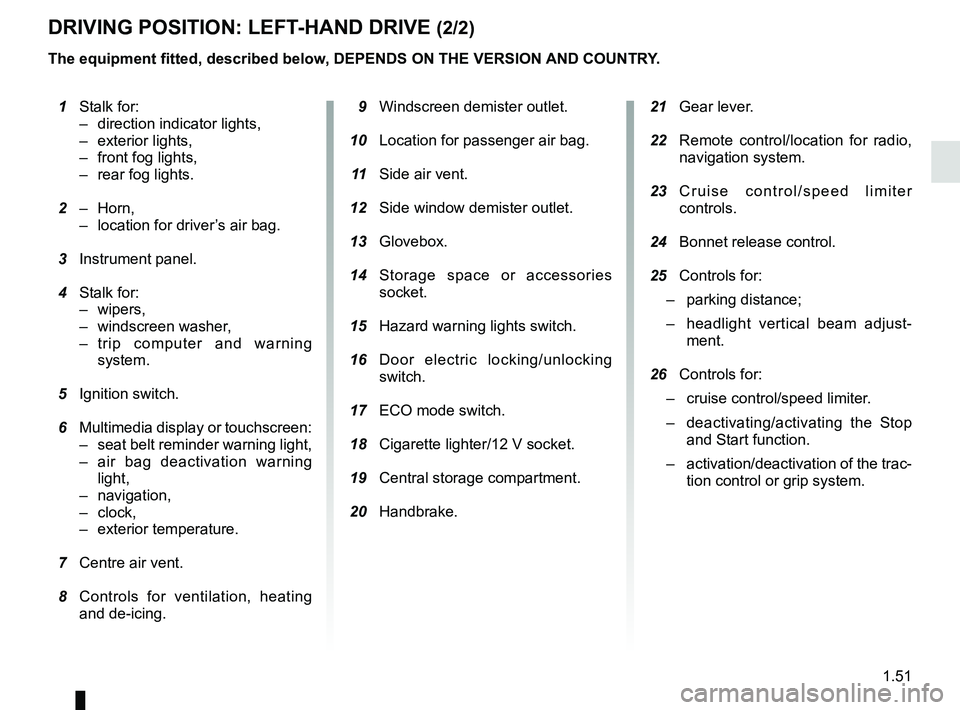
1.51
21 Gear lever.
22 Remote control/location for radio,
navigation system.
23 Cruise control/speed limiter
controls.
24 Bonnet release control.
25 Controls for:
– parking distance;
– headlight vertical beam adjust-
ment.
26 Controls for:
– cruise control/speed limiter.
– deactivating/activating the Stop
and Start function.
– activation/deactivation of the trac-
tion control or grip system.
1 Stalk for:
– direction indicator lights,
– exterior lights,
– front fog lights,
– rear fog lights.
2 – Horn,
– location for driver’s air bag.
3 Instrument panel.
4 Stalk for:
– wipers,
– windscreen washer,
– trip computer and warning system.
5 Ignition switch.
6 Multimedia display or touchscreen:
– seat belt reminder warning light,
– air bag deactivation warning light,
– navigation,
– clock,
– exterior temperature.
7 Centre air vent.
8 Controls for ventilation, heating
and de-icing. 9 Windscreen demister outlet.
10 Location for passenger air bag.
11 Side air vent.
12 Side window demister outlet.
13 Glovebox.
14 Storage space or accessories
socket.
15 Hazard warning lights switch.
16 Door electric locking/unlocking
switch.
17 ECO mode switch.
18 Cigarette lighter/12 V socket.
19 Central storage compartment.
20 Handbrake.
DRIVING POSITION: LEFT-HAND DRIVE (2/2)
The equipment fitted, described below, DEPENDS ON THE VERSION AND COUNTRY.
Page 154 of 264
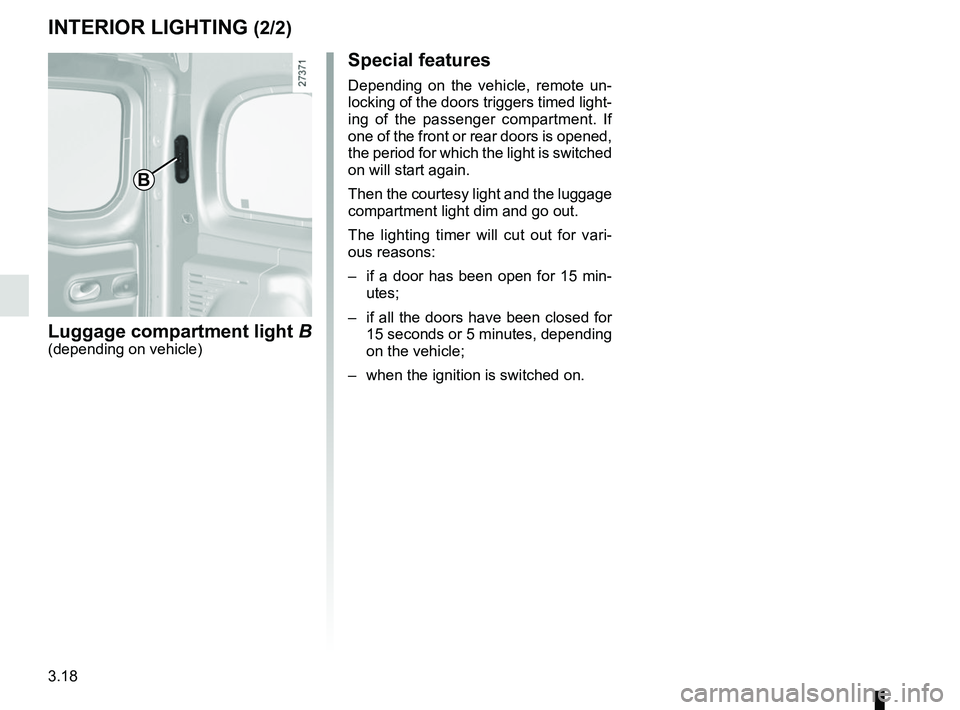
3.18
Special features
Depending on the vehicle, remote un-
locking of the doors triggers timed light-
ing of the passenger compartment. If
one of the front or rear doors is opened,
the period for which the light is switched
on will start again.
Then the courtesy light and the luggage
compartment light dim and go out.
The lighting timer will cut out for vari-
ous reasons:
– if a door has been open for 15 min-utes;
– if all the doors have been closed for 15 seconds or 5 minutes, depending
on the vehicle;
– when the ignition is switched on.
B
Luggage compartment light B(depending on vehicle)
INTERIOR LIGHTING (2/2)
Page 156 of 264
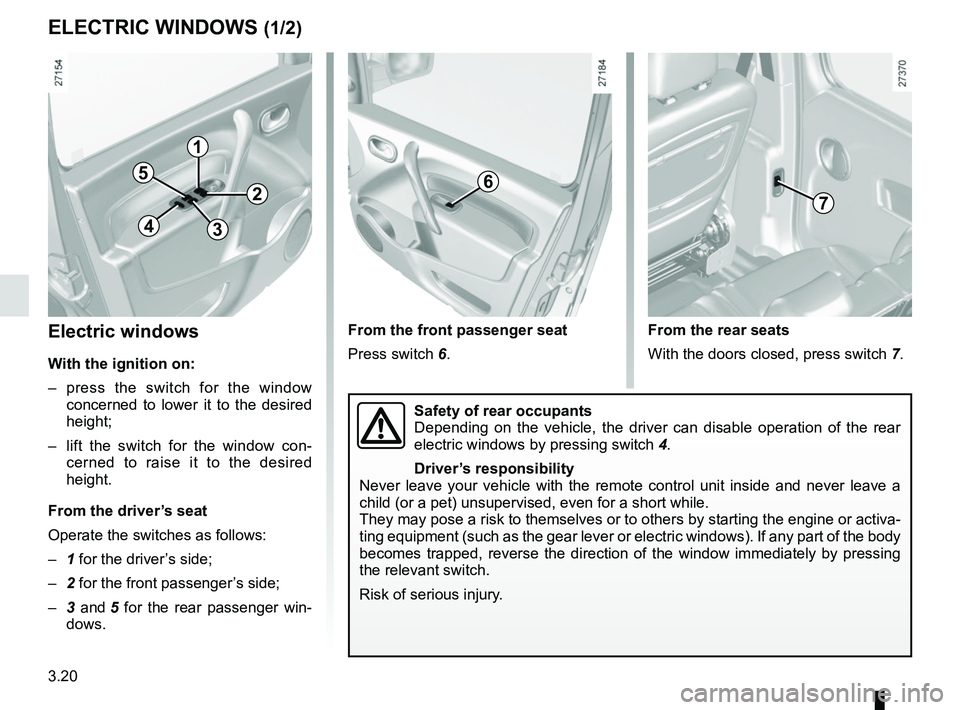
3.20
Electric windows
With the ignition on:
– press the switch for the window concerned to lower it to the desired
height;
– lift the switch for the window con- cerned to raise it to the desired
height.
From the driver’s seat
Operate the switches as follows:
– 1 for the driver’s side;
– 2 for the front passenger’s side;
– 3 and 5 for the rear passenger win-
dows.
ELECTRIC WINDOWS (1/2)
From the rear seats
With the doors closed, press switch 7.
From the front passenger seat
Press switch 6.
1
2
34
56
Safety of rear occupants
Depending on the vehicle, the driver can disable operation of the rear
electric windows by pressing switch
4.
Driver’s responsibility
Never leave your vehicle with the remote control unit inside and never l\
eave a
child (or a pet) unsupervised, even for a short while.
They may pose a risk to themselves or to others by starting the engine o\
r activa-
ting equipment (such as the gear lever or electric windows). If any pa\
rt of the body
becomes trapped, reverse the direction of the window immediately by pres\
sing
the relevant switch.
Risk of serious injury.
7
Page 231 of 264
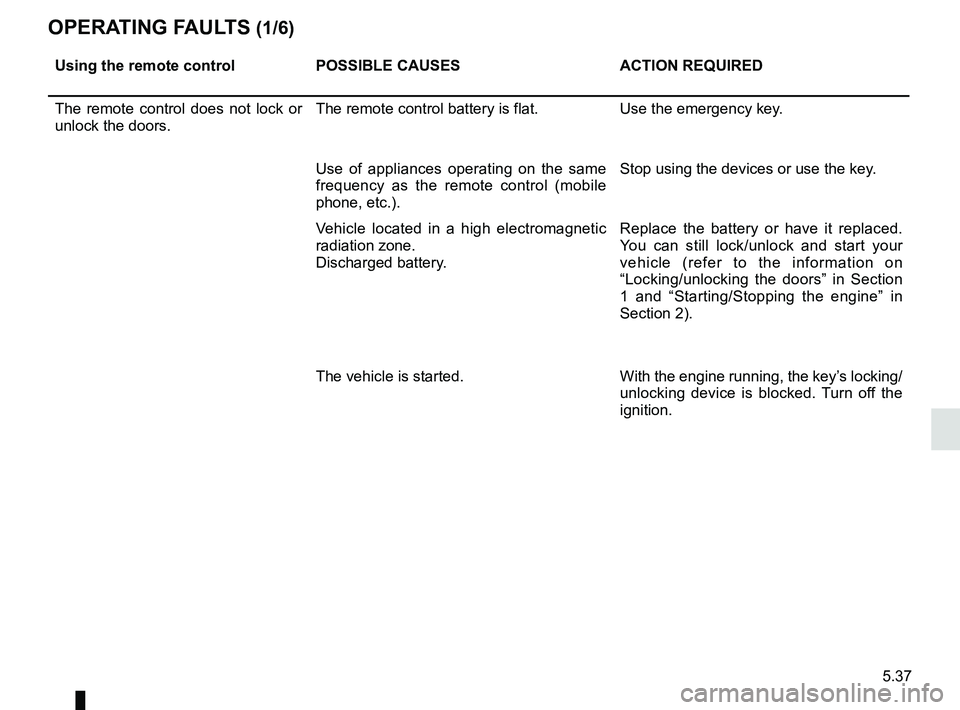
5.37
OPERATING FAULTS (1/6)
Using the remote controlPOSSIBLE CAUSES ACTION REQUIRED
The remote control does not lock or
unlock the doors. The remote control battery is flat.
Use the emergency key.
Use of appliances operating on the same
frequency as the remote control (mobile
phone, etc.). Stop using the devices or use the key.
Vehicle located in a high electromagnetic
radiation zone.
Discharged battery. Replace the battery or have it replaced.
You can still lock/unlock and start your
vehicle (refer to the information on
“Locking/unlocking the doors” in Section
1 and “Starting/Stopping the engine” in
Section 2).
The vehicle is started. With the engine running, the key’s locking/
unlocking device is blocked. Turn off the
ignition.
Page 260 of 264

7.4
ALPHABETICAL INDEX (4/5)
radio frequency remote control/keyuse ....................................................................\
...... 1.2, 1.4
rear bench seat....................................................... 3.29 – 3.30
rear lights changing bulbs .................................................5.19 → 5.21
rear parcel shelf ................................................................. 3.33
rear screen demisting ..............................................................\
.. 3.2, 3.4
rear seats functions ........................................................... 3.29 – 3.30
rear view camera .................................................... 2.40 – 2.41
rear view mirrors ..................................................... 1.72 – 1.73
remote control electric door locking .............................. 1.2, 1.4
RENAULT ANTI-INTRUDER DEVICE (RAID) ................... 1.14
replacement parts ................................................................ 6.9
reverse gear selecting ....................................................2.7, 2.42 → 2.44
reversing sensor ..................................................... 2.38 – 2.39
roof bars ........................................................................\
.... 3.35
running in ........................................................................\
..... 2.2
S
seat belts ......................................................1.25 → 1.33, 1.57
see-me-home lighting ........................................................ 1.76
service sheets........................................................6.10 → 6.15
side indicator lights changing bulbs ............................................................. 5.22
side protection devices ...................................................... 1.32
side windows ..................................................................... 3.21
signals and lights ...................................................1.75 → 1.77
speakers ...............................................................\
............. 5.34
special features of diesel versions..................................... 2.10
special features of petrol vehicles ....................................... 2.9
speed limiter .................................................1.57, 2.31 → 2.33
starting the engine .....................................................2.3 → 2.6steering wheel
adjustment .............................................................\
...... 1.49
Stop & Start ....................................................................... 1.57
stopping the engine ...................................................2.3 → 2.6
storage compartment.............................................3.24 → 3.28
storage compartments ...........................................3.24 → 3.28
sun visor ................................................................... 3.19, 3.25
sunroof........................................................................\
....... 3.22
T
tailgate ................................................. 1.9 → 1.11, 3.31 – 3.32
technical specifications .......................6.2, 6.4 – 6.5, 6.7 → 6.9
temperature regulation ............................................3.4 → 3.16
tool kit ........................................................................\
.......... 5.8
towing .................................................................\
................. 6.6 breakdown ..............................................................\
..... 5.31
towing a caravan ................................................................. 6.6
towing equipment fitting ................................................................\
............ 3.32
towing hitch................................................................. 5.8, 5.31
towing rings ............................................................ 1.37 – 1.38
towing weights ..................................................................... 6.6
traction control ..............................................1.57, 2.26 → 2.30
transporting children ..........................1.34 – 1.35, 1.37 → 1.48
transporting objects in the luggage compartment ............................. 3.31 – 3.32
trims ..................................................................\
................. 5.10
trip computer and warning system.........................1.61 → 1.69
turning circle ............................................................... 6.7 – 6.8
tyre inflation kit...........................................................5.4 → 5.7
tyre pressure........................... 2.17 → 2.25, 2.22 → 2.25, 4.13
tyre pressure loss warning............... 2.17 → 2.25, 2.22 → 2.25
tyre pressures ....................................4.13 – 4.14, 5.13 → 5.15
tyres .................. 2.17 → 2.25, 2.22 → 2.25, 4.13, 5.13 → 5.15